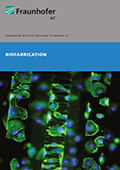LIFT allows bioactive materials, proteins, bacteria and mammalian cells to be placed gently and precisely on any surface. A pulsed laser source is used to evaporate a sacrificial absorption layer thereby transferring small amounts of material from a target to a substrate. The target consists of three layers: a support layer that is transparent to the wavelength of interest, a transfer layer that contains the substance to be transferred, and an absorption layer between the support and transfer layer. This nozzle free transfer technology allows the handling of smallest quantities of materials without any demand on viscosity or physical state. Highly viscous films, solid materials and even light cells can be transferred. At Fraunhofer ILT the user friendly tool LIFTSYSTM was developed which allows the use of this technology for research groups and industry. A coaxial monitoring system allows the analysis of the transfer layer before the actual transfer. Semi-automated routines perform actions like triggering transfer, positioning of substrates and srcibing of patterns as well as the creation of images for documentation.
This methodology offers new fabrication possibilities. For example, it is possible to generate 3D microstructures inside a closed microfluidic device. The versatility enables scaffolds that closely mimic the natural environment of cells. Generally, the high costs of a TPP prototyping setup hinders the widespread application of this promising technology. Therefore, a cost-efficient table top module has been developed with all necessary features for 3D micro-structuring. This module is specially designed for easy incorporation into other biofabrication processes and is available for SLA and TPP processes.

 Fraunhofer Institute for Laser Technology ILT
Fraunhofer Institute for Laser Technology ILT